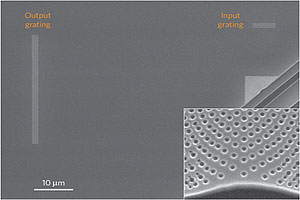
A scanning electron microscope image of an invisibility cloak recently fabricated by Valentine et al. at UC Berkeley. The inset at lower right shows a close-up of the triangular cloak and the corresponding bump that the experiment worked to conceal. Reprinted by permission from Macmillan Publishers Ltd: Nature Materials 8, 568 - 571, copyright 2009.The concept of the invisible has long fascinated us as a human race. We find ourselves seduced by the voyeuristic potential of Harry Potter's cloak, chilled by the prospect of unseen demons in movies and untraceable disease epidemics in life. In literature, "the invisible man/woman" has taken on identities of a diabolical monster in the hands of H.G. Wells, a comic book superhero under the direction of Stan Lee and Jack Kirby, and a metaphor to punctuate injustice in the eyes of Ralph Ellison.
While invisibility has been largely the stuff of fiction and allegory, that may only be true a short while longer. Two papers published by groups at UC Berkeley and Cornell have recently demonstrated that objects can now be rendered invisible at wavelengths nearly (but still not quite!) short enough to fool human eyes. The technique has come to be known as optical cloaking.
How does it work? Essentially, cloaking makes an object appear invisible by wrapping the object in a metamaterial designed to bend light. Such bending is common in everyday life, seen for example when you look though a glass of water. The genius of a metamaterial is that it has been carefully crafted to bend light exactly to where it would have gone in the absence of the cloaked object. As a result, both object and cloak are rendered invisible.
In 2006, the first physical version of this concept was demonstrated at Duke in the form of a microwave invisibility cloak. It was not without limitations. Imagine a magic rug that, when wrapped around a standing person, makes the person invisible to only one color, and unfortunately not even a color you can see with bare eyes. You would need something like a radar detector to see how invisible they were. Nevertheless, it was stunning demonstration of the cloaking principle.
The push since this first demonstration has been to extend the properties of this to ever shorter wavelengths, and the Berkeley and Cornell groups (respectively headed by Xiang Zhang and Michal Lipson) have succeeded in doing that with a newly designed "carpet cloak." The new design works quite literally by sweeping an object under a rug. An irregular bump on an otherwise flat conductor is covered with the carpet cloak. Then, when light bounces off both cloak and conductor, the cloak rearranges rays of light to make it appear as if the entire surface were flat.
